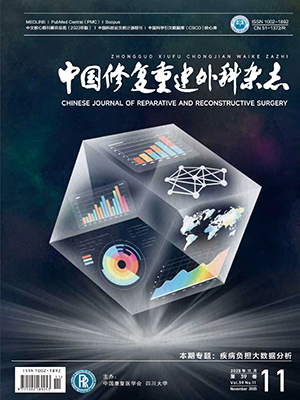Objective To investigate the effects of chondroitinase ABC (ChABC) combined with bone marrow mesenchymal stem cells (BMSCs) in repair spinal cord injury of rats. Methods Primary BMSCs were isolated and cultured from the femur and tibia of neonatal Sprague Dawley (SD) rats. The spinal cord injury model was established in 24 adult SD male rats (weighing, 200-230 g), which were randomly divided into control group (group A), BMSCs transplantation group (group B), ChABC injection group (group C), and ChABC and BMSCs transplantation group (group D), 6 rats in each group. At 7 and 14 days after injury, Basso-Beattie-Bresnahan (BBB) score criteria was used to evaluate the hindlimb motor function; at 14 days after injury, the injured spinal cord tissue was perfused and stained by HE for further calculation of the injury area. Immunofluorescence staining were used for observing the expressions of glial fibrillary acidic protein (GFAP)/chondroitin sulfate proteoglycan (CSPG) and GFAP/growth associated protein 43 (GAP43). Results At 7 days after injury, three joints movement of the hindlimbs were recovered in all groups, and no significant difference in the BBB score was found among 4 groups (P gt; 0.05). At 14 days after injury, no load drag was observed in 3 joints of the hindlimbs in groups A, B, and C, but weight-bearing plantar or occasional dorsalis pedis weight-bearing walking was observed in group D with no plantar walking. The BBB score of group D was significantly higher than that of the other 3 groups (P lt; 0.05). HE staining showed that the cavity formed in the damage zone, and there were a large number of macrophages in the cavity and its surrounding, which was wrapped by scar tissue. The damage area of group D was significantly smaller than that of the other 3 groups (P lt; 0.05). At 14 days after injury, the GFAP/CSPG double immunofluorescence staining showed that the astroglial scar damage zone in group D was significantly reduced, and no cavity formation was found. And the fluorescence intensity in groups C and D was significantly lower than that in group B (P lt; 0.05). The GFAP/GAP43 double immunofluorescence staining showed that GAP43-positive fibers passed through the damage zone in group D and the fluorescence intensity in group D was significantly higher than those in groups B and C (P lt; 0.05). Conclusion Inhibition of astrocytes secreting CSPG by ChABC combined with BMSCs transplantation in early injury may promote the regeneration of nerve fibers, and repair spinal cord injury in rats.
Citation: ZHANG Chun,HE Xijing,LI Haopeng.. EFFETS OF CHONDROITINASE ABC COMBINED WITH BONE MARROW MESENCHYMAL STEM CELLS TRANSPLANTATION ON REPAIR OF SPINAL CORD INJURY IN RATS. Chinese Journal of Reparative and Reconstructive Surgery, 2013, 27(5): 541-546. doi: 10.7507/1002-1892.20130121 Copy
Copyright ? the editorial department of Chinese Journal of Reparative and Reconstructive Surgery of West China Medical Publisher. All rights reserved




